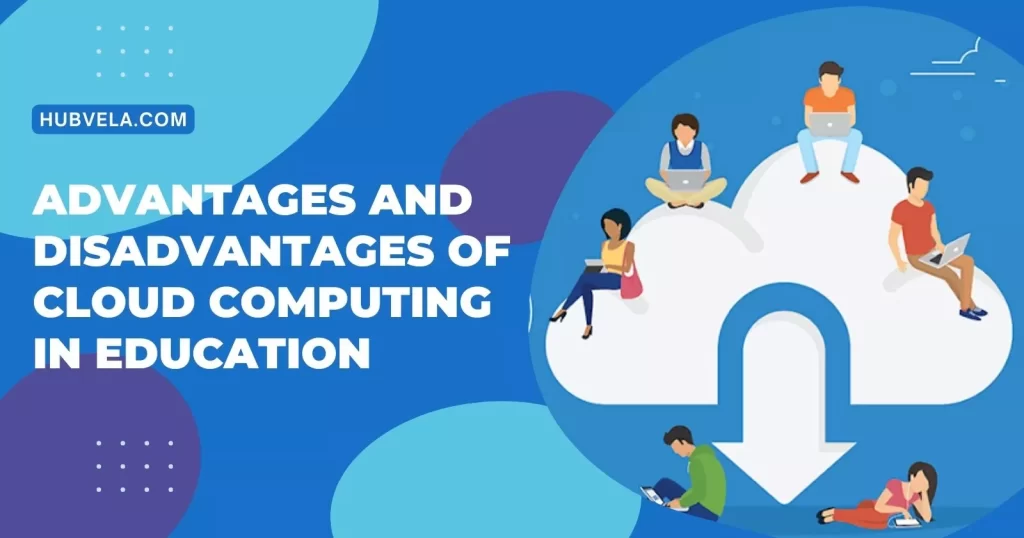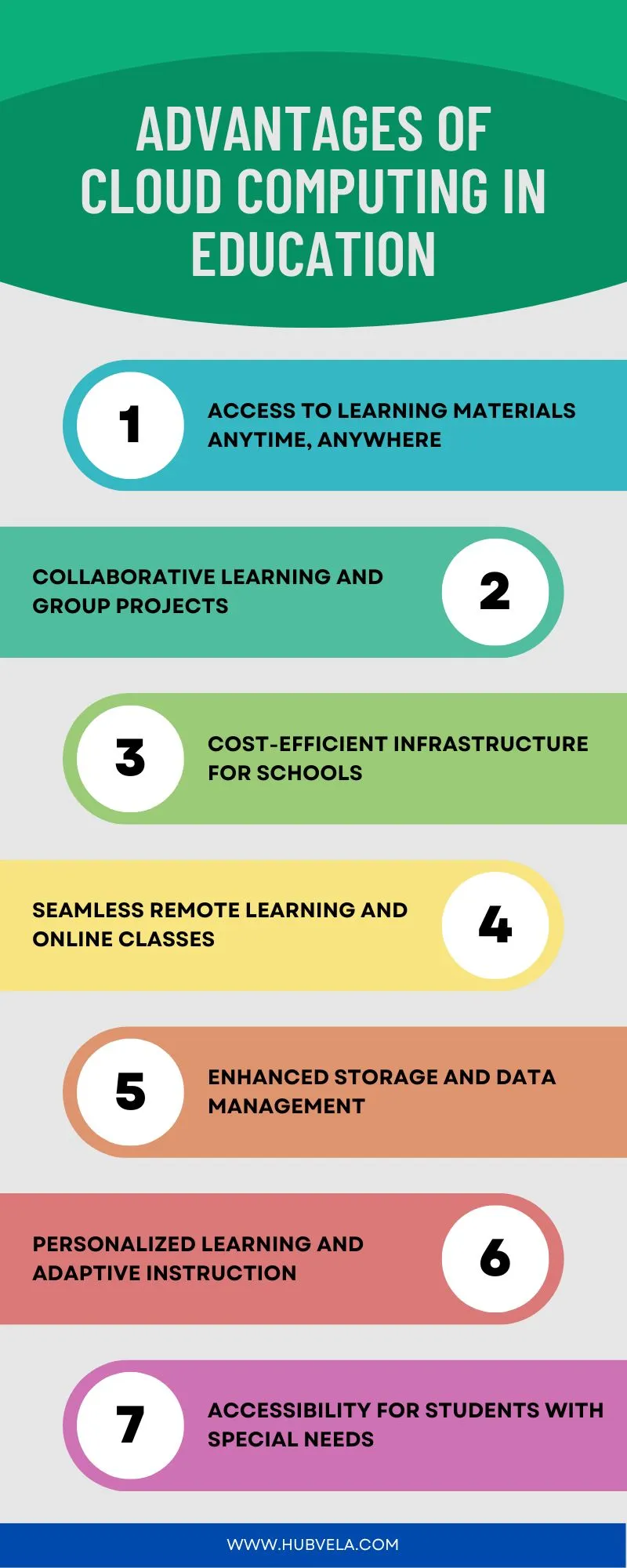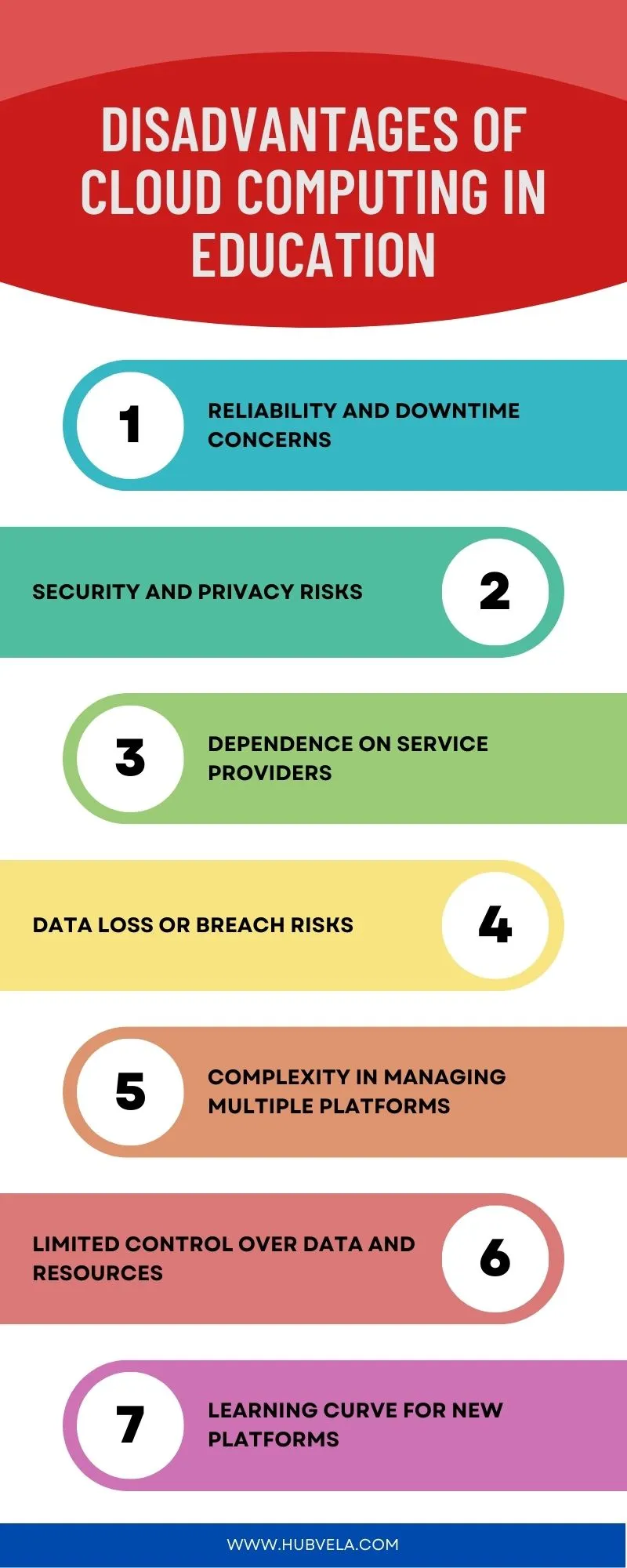Cloud computing has become an increasingly popular technology in the education sector. It involves the use of remote servers to store, manage, and process data, allowing users to access information and applications from anywhere with an internet connection.
The benefits of cloud computing in education include long-term cost savings, better collaboration, and easy accessibility to resources.
However, there are also some drawbacks to consider, such as dependence on internet service providers, data security concerns, and up-front costs for migration and training.
In this article, we will explore the advantages and disadvantages of cloud computing in education in more detail.

--Advertisement--
Advantages of Cloud Computing in Education
Cloud computing has become an essential tool in various industries, including education. Cloud computing refers to delivering information technology resources on demand via the internet, allowing users to access tools as needed from a cloud provider.
The cloud has significantly changed the education sector, offering online programs and modifying the traditional working ecosystem. We will explore the advantages of cloud computing in education.

1. Access to Learning Materials Anytime, Anywhere
Access to learning materials anytime, anywhere is a significant advantage of cloud computing in education. Cloud computing allows students and educators to access educational resources, software tools, and learning materials from any internet-connected device, enabling personalized learning experiences and seamless collaboration.
This accessibility not only supports flexible and remote learning but also reduces the need for physical resources, such as textbooks and paper, contributing to cost-effectiveness and eco-friendliness.
While there are upfront costs and challenges associated with cloud migration, the long-term cost savings and improved access to resources make cloud computing a valuable asset in modern education.
2. Collaborative Learning and Group Projects
Cloud computing facilitates improved collaboration and communication among students and instructors, allowing for easier access to resources and enhancing productivity and efficient educational practices.
This technology enables students to work together on group projects and assignments seamlessly, regardless of their physical location, fostering a more inclusive and flexible learning environment.
Additionally, cloud computing in education can lead to long-term cost savings by reducing operational and management toil, as well as providing backup of information and support in financial and HR management.
3. Cost-Efficient Infrastructure for Schools
Cloud computing offers a cost-efficient infrastructure for schools, providing several benefits that contribute to reducing IT costs for educational institutions.
One of the primary advantages is the reduction in hardware costs, as cloud migration supports an IT ecosystem by helping institutions shift from capital expenses to predictable monthly operational expenses.
This shift brings about reduced data storage costs, minimal data center maintenance, and less expenditure on replacing aging physical IT hardware.
Additionally, cloud computing allows educational institutions to use cloud services on a rental basis, lowering capital expenses and operating costs, as they only pay for the resources they use.
4. Seamless Remote Learning and Online Classes
Cloud computing has become an essential part of education, enabling seamless remote learning and online classes. One of the main benefits of cloud computing in education is cost reduction, which is achieved through long-term savings in operational IT costs.
Cloud computing also enables better collaboration among students and teachers, allowing for real-time communication and access to shared resources.
Additionally, cloud computing provides easy accessibility to resources and software tools, enhancing the learning experience for students.
5. Enhanced Storage and Data Management
Cloud computing offers several advantages in education, including enhanced storage and data management. Cloud-based education platforms can reduce data storage costs, minimize data center maintenance, and reduce the need to replace aging physical IT hardware.
Cloud computing also improves physical and digital access to resources, making it easier for students to access the same materials and learning resources regardless of the devices or internet browsers they use.
Additionally, cloud-based applications can be accessed on internet browsers, reducing the need for expensive hardware and external storage devices.
Incorporating cloud computing in the education sector can save time and effort for both faculty and students due to greater flexibility, and processes that once required both parties to be present at the school, college, or university can now be completed remotely and in a fraction of the time.
Properly implemented, cloud computing education systems can cost less than a traditional education from a renowned institution, and minimizing paper use also saves resources, eliminating printers, photocopiers, and physical storage space.
6. Personalized Learning and Adaptive Instruction
Cloud computing in education offers several advantages, particularly in the realm of personalized learning and adaptive instruction.
By harnessing the capabilities of cloud-based learning platforms, educators can create tailored learning experiences that cater to individual needs and foster deeper engagement.
This personalized approach fosters greater engagement, tailors instruction to individual needs, and maximizes learning outcomes.
Cloud computing allows teachers to provide a more personalized learning experience for students by analyzing student data and learning patterns, providing targeted instruction and practice that caters to each student’s unique learning style, ability, and pace.
Additionally, cloud-based learning platforms enable educators to provide personalized feedback and support to students, fostering a positive and supportive learning environment.
Furthermore, cloud computing affords opportunities for larger student selection in learning, as students can access a wide array of resources and software tools that suit their learning styles and interests.
Cloud computing in education enhances personalized learning and adaptive instruction, offering flexibility in content delivery and fostering a positive and supportive learning environment.
7. Accessibility for Students with Special Needs
Cloud computing can provide significant benefits for students with special needs, improving their access to education and other services.
Accessible cloud-based technologies can ensure that students with disabilities have access to services and content in today’s increasingly digital world, and can also power new services that provide greater independence and mobility for people with a wide range of disabilities.
Cloud-based environments can also provide assistive software to students with disabilities, such as magnification software, screen readers, and learning disability software, which can also benefit students without disabilities.
Cloud-based solutions can help deploy software within days instead of weeks or months, and with students no longer having to visit a special education center to use these applications, there are far fewer barriers to them continuing with their studies through to graduation.
Cloud-based library resources, such as audio books and literature, can also be accessed by students with special needs. Cloud computing can improve accessibility for students with special needs and provide them with greater flexibility and independence in their education.
Disadvantages of Cloud Computing in Education
Cloud computing has become an integral part of the education sector, offering numerous benefits such as cost reduction, improved collaboration, and seamless access to resources.
However, alongside these advantages, there are also several drawbacks and challenges associated with the adoption of cloud computing in education.
We will explore the disadvantages of cloud computing in education.

1. Reliability and Downtime Concerns
Reliability and Downtime Concerns in cloud computing in education are significant considerations that need to be addressed.
While cloud computing offers benefits such as long-term cost savings, seamless collaboration, and complete resource availability, it also presents challenges related to downtime and reliability.
Dependence on internet service providers can lead to service outages or poor bandwidth, detracting from online learning experiences.
Additionally, the risk of downtime and potential security vulnerabilities are important factors to consider when evaluating the reliability of cloud computing in education.
Institutions need to carefully weigh the advantages and disadvantages of cloud computing to ensure that they can effectively manage and mitigate the potential downtime concerns associated with this technology.
It is essential for educational institutions to have a comprehensive understanding of these challenges and to develop strategies to address them in order to ensure a reliable and uninterrupted learning environment for students and educators.
2. Security and Privacy Risks
Security and privacy risks in cloud computing have become a significant concern in the education sector. As more educational institutions and EdTech companies migrate to cloud-based solutions, the risk of data breaches and privacy violations increases.
The personal information of students, and educators, as well as sensitive financial and operational data, is at risk if not properly protected.
A study focusing on K-12 public education in the United States found that the protection of student privacy in the context of cloud computing is generally unknown to the public and policymakers, highlighting the salient and contentious nature of privacy issues.
Breaches of educational data can lead to a violation of the Family Educational Rights and Privacy Act (FERPA) and have negative consequences for students, such as identity theft and fraud.
Therefore, it is crucial for educational institutions to take appropriate steps to safeguard student records and enhance the security of their information systems.
The shift towards digital education and the use of cloud-based services necessitates a proactive approach to address security and privacy risks, emphasizing the importance of using certified cloud providers and implementing best practice guidance for data security and management.
3. Dependence on Service Providers
Dependence on service providers is a significant drawback of cloud computing in education. Educational institutions relying on cloud computing become more reliant on internet service providers, which can lead to service outages or poor bandwidth, detracting from online learning.
Additionally, cloud computing in education is often dependent on a single vendor, making it difficult to switch service providers. This reliance on service providers can also have cost implications and raise concerns about data security.
As a result, educational institutions need to carefully consider the potential drawbacks of cloud computing and weigh them against the benefits to make informed decisions about integrating cloud technology into their learning environments.
4. Data Loss or Breach Risks
When it comes to cloud computing in education, there are significant risks associated with data loss or breaches.
The shift towards cloud-based solutions in educational technology has increased the risk of data breaches, potentially leading to the loss of personal information of students and educators, as well as sensitive financial and operational data.
Educational organizations, especially K-12 schools, are concerned about the leaking or losing of student data, which has been identified as the biggest fear in the context of cloud computing in education.
Additionally, the use of cloud-based tools from multiple locations and devices makes it harder for IT teams to maintain visibility into their users, increasing the risk of data breaches and loss.
Furthermore, the inadvertent access to data and the loss of that data to malicious insiders and cyber criminals are also significant concerns.
Therefore, it is crucial for educational institutions to develop robust security measures, including data loss prevention (DLP) policies and processes, and create training and awareness programs surrounding the proper usage of the cloud and its potential impact on private and sensitive information if used incorrectly.
Stronger security measures are required to mitigate these risks and ensure the protection of sensitive data in the cloud.
5. Complexity in Managing Multiple Platforms
The shift to virtual learning has led to increased demands for digital literacies and the need to communicate across different platforms.
Digital platforms in education are not just discrete tools, but rather complex environments or “ecologies” where various stakeholders interact, influencing teaching and learning in multifaceted ways.
Additionally, the technological complexity of e-learning platforms can pose challenges for instructors, affecting their acceptance and perception of these systems.
This complexity requires a leader’s framework for understanding and managing change in higher education, especially in the rapidly changing educational contexts of today.
Therefore, managing multiple platforms in education, particularly in the cloud computing context, requires a deep understanding of the interconnectedness of these platforms, the social uses, design decisions, and the material resources they require, in order to effectively navigate and leverage their potential for enhancing learning experiences.
6. Limited Control Over Data and Resources
Limited control over data and resources is a significant disadvantage of cloud computing in education. Cloud services run on remote servers that are entirely owned, managed, and monitored by the cloud service provider, which means educational institutions have minimal control over their deployments.
This lack of control extends to updates, training, and other features, which can be concerning for administrators who need to ensure the security and privacy of student data.
Additionally, the end-user license agreement (EULA) and management policies of cloud providers might impose limits on what customers can do, further restricting their control and flexibility.
Therefore, while cloud computing offers accessibility to services and platforms, educational institutions must carefully consider the trade-offs between the benefits and the level of control they require over their data and resources when integrating cloud solutions into their learning environments.
7. Learning Curve for New Platforms
The learning curve for new platforms, such as cloud technology, can present challenges in the education sector. While cloud computing offers benefits like scalability, cost reduction, and seamless collaboration, it also brings drawbacks that educators and students need to navigate.
One significant disadvantage is the disparity in digital literacy between teachers, especially from older generations, and students born in the digital age.
This can lead to a significant learning curve for teachers who may struggle to adapt to technological advances, impacting their ability to effectively integrate cloud technology into their teaching methods.
Similarly, students from less technologically advanced environments may face challenges in meeting the technical requirements of their studies, highlighting the need for support and resources to bridge this gap.
As educational institutions increasingly rely on cloud computing, addressing the learning curve for new platforms becomes crucial to ensure a smooth transition and effective utilization of technology in education.
Conclusion on Advantages and Disadvantages of Cloud Computing in Education
Cloud computing in education offers several advantages and disadvantages. The benefits include long-term cost savings, improved collaboration and communication, easier access to resources, scalability, and enhanced productivity.
These advantages can lead to reduced operational and management costs, improved educational practices, and support in financial and HR management.
On the other hand, there are some drawbacks to consider, such as higher up-front investment, dependence on internet service providers, security issues, and ongoing costs.
Additionally, there may be challenges related to migration costs, training, and changing cloud service providers. Despite these drawbacks, the benefits of cloud computing in education can significantly impact the learning environment and create new educational opportunities.
Therefore, while there are considerations to be mindful of, the overall impact of cloud computing in education is positive and transformative.


